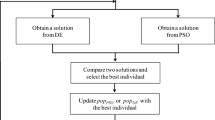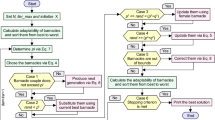Abstract
Self-potential (SP) method has many applications, where the interpretation of SP data can be used for qualitative and quantitative interpretation. However, inversion of SP data in this paper is of quantitative interpretation and consists of highly non-linear, multimodal data and deploys global optimum method (GOM). Micro-differential evolution (MDE) is a GOM with small or micro-population size (5–8 populations) for each iteration. Consequently, this approach involves small numbers of forward computation in the inversion process. Two MDE variants, including adaptive MDE (\( \mu \)JADE) and vectorized random mutation factor (MVDE) were tested first for different level of noises containing synthetic SP data with single anomaly and applied to synthetic SP data of multiple anomalies. The MDE variants are reliable and effective for inverting noisy SP data. Furthermore, in order to check the rationality of MDE variants, the algorithm is applied to seven field data from different applications, including groundwater exploration, shear zone tracing, water accumulation in landslides and embankment stability assessment. The model parameters revealed by MDE variants are accurate and show good agreement with the previous results estimated using other approaches. In addition, MDE variants also require fewer forward modelling calculations than other optimization approaches.
















Similar content being viewed by others
References
Abdelazeem M, Gobashy M, Khalil M H and Abdrabou M 2019 A complete model parameter optimization from self-potential data using Whale algorithm; J. Appl. Geophys. 170 103825.
Agarwal B N P and Srivastava S 2009 Analyses of self-potential anomalies by conventional and extended Euler deconvolution techniques; Comput. Geosci. 35 2231–2238.
Arora T, Linde N, Revil A and Castermant J 2007 Non-intrusive characterization of the redox potential of landfill leachate plumes from self-potential data; J. Contam. Hydrol. 92 274–292.
Balkaya Ç 2013 An implementation of differential evolution algorithm for inversion of geoelectrical data; J. Appl. Geophys. 98 160–175.
Balkaya Ç, Ekinci Y L, Göktürkler G and Turan S 2017 3D non-linear inversion of magnetic anomalies caused by prismatic bodies using differential evolution algorithm; J. Appl. Geophys. 136 372–386.
Biswas A 2017 A review on modeling, inversion and interpretation of self-potential in mineral exploration and tracing paleo-shear zones; Ore Geol. Rev. 91 21–56.
Biswas A and Sharma S P 2015 Interpretation of self-potential anomaly over idealized bodies and analysis of ambiguity using very fast simulated annealing global optimization technique; Surf. Geophys. 13 179–195.
Biswas A and Sharma S P 2014a Integrated geophysical studies to elicit the subsurface structures associated with Uranium mineralization around South Purulia Shear Zone, India: A review; Ore Geol. Rev. 72(2) 1307–1326.
Biswas A and Sharma S P 2014b Optimization of self-potential interpretation of 2-D inclined sheet-type structures based on very fast simulated annealing and analysis of ambiguity; J. Appl. Geophys. 105 235–247.
Biswas A and Sharma S P 2014c Resolution of multiple sheet-type structures in self-potential measurement; J. Earth Syst. Sci. 123 809–825.
Brown C, Jin Y, Leach M and Hodgson M 2016 μJADE: Adaptive differential evolution with a small population; Soft Comput. 20 4111–4120.
Byrdina S, Rücker C, Zimmer M, Friedel S and Serfling U 2012 Self potential signals preceding variations of fumarole activity at Merapi volcano, Central Java; J. Volcanol. Geotherm. Res. 215–216 40–47.
Candra A D, Srigutomo W, Sungkono and Santosa B J 2014 A complete quantitative analysis of self-potential anomaly using singular value decomposition algorithm; In: IEEE International Conference on Smart Instrumentation, Measurement and Applications (ICSIMA), pp. 1–4.
Di Maio R, Piegari E, Rani P, Carbonari R, Vitagliano E and Milano L 2019 Quantitative interpretation of multiple self-potential anomaly sources by a global optimization approach; J. Appl. Geophys. 162 152–163.
Di Maio R, Rani P, Piegari E and Milano L 2016 Self-potential data inversion through a genetic-price algorithm; Comput. Geosci. 94 86–95.
Ekinci Y L, Balkaya Ç and Göktürkler G 2020 Global optimization of near-surface potential field anomalies through metaheuristics; In: Advances in Modeling and Interpretation in Near Surface Geophysics (eds) Biswas A and Sharma S P Springer Geophysics, Springer, Cham, pp. 155–188.
Ekinci Y L, Balkaya Ç and Göktürkler G 2019 Parameter estimations from gravity and magnetic anomalies due to deep-seated faults: Differential evolution versus particle swarm optimization; Turk. J. Earth Sci. 28 860–881.
Ekinci Y L, Balkaya Ç, Göktürkler G and Turan S 2016 Model parameter estimations from residual gravity anomalies due to simple-shaped sources using differential evolution algorithm; J. Appl. Geophys. 129 133–147.
Ekinci Y L, Özyalın Ş, Sındırgı P, Balkaya Ç and Göktürkler G 2017 Amplitude inversion of the 2D analytic signal of magnetic anomalies through the differential evolution algorithm; J. Geophys. Eng. 14 1492–1508.
El-Kaliouby H M and Al-Garni M A 2009 Inversion of self-potential anomalies caused by 2D inclined sheets using neural networks; J. Geophys. Eng. 6 29.
Fajriani Srigutomo W and Pratomo P M 2017 Interpretation of self-potential anomalies for investigating fault using the Levenberg–Marquardt method: A study case in Pinggirsari, West Java, Indonesia; IOP Conf. Ser. Earth Environ. Sci. 62 012004.
Fernández-Martínez J L, Pallero J L G, Fernández-Muñiz Z and Pedruelo-González L M 2014a The effect of noise and Tikhonov’s regularization in inverse problems. Part II: The nonlinear case; J. Appl. Geophys. 108 186–193.
Fernández-Martínez J L, Pallero J L G, Fernández-Muñiz Z and Pedruelo-González L M 2014b The effect of noise and Tikhonov’s regularization in inverse problems. Part I: The linear case; J. Appl. Geophys. 108 176–185.
Gobashy M, Abdelazeem M, Abdrabou M and Khalil M H 2019 Estimating model parameters from self-potential anomaly of 2D inclined sheet using whale optimization algorithm: Applications to mineral exploration and tracing shear zones; Nat. Resour. Res. 29 499–519.
Göktürkler G and Balkaya Ç 2012 Inversion of self-potential anomalies caused by simple-geometry bodies using global optimization algorithms; J. Geophys. Eng. 9 498–507.
Göktürkler G, Balkaya Ç, Erhan Z and Yurdakul A 2008 Investigation of a shallow alluvial aquifer using geoelectrical methods: A case from Turkey; Environ. Geol. 54 1283–1290.
Husein A, Sungkono, Wijaya A and Hadi S 2014 Subsurface monitoring of P.79–P.82 LUSI Embankment using GPR method to locate subsidence and possible failure; In: 15th International Conference on Ground Penetrating Radar (GPR), Brussels, Belgium, pp. 268–273.
Jardani A, Revil A and Dupont J P 2006 Self-potential tomography applied to the determination of cavities; Geophys. Res. Lett. 33 L13401.
Lapenna V, Lorenzo P, Perrone A, Piscitelli S, Sdao F and Rizzo E 2003 High-resolution geoelectrical tomographies in the study of Giarrossa landslide (southern Italy); Bull. Eng. Geol. Environ. 62 259–268.
Li X and Yin M 2012 Application of differential evolution algorithm on self-potential data; PLoS ONE 7 e51199.
Mehanee S A 2015 Tracing of paleo-shear zones by self-potential data inversion: Case studies from the KTB, Rittsteig, and Grossensees graphite-bearing fault planes; Earth Planets Space 67 14.
Mehanee S A 2014 An efficient regularized inversion approach for self-potential data interpretation of ore exploration using a mix of logarithmic and non-logarithmic model parameters; Ore Geol. Rev. 57 87–115.
Monteiro Santos F A 2010 Inversion of self-potential of idealized bodies’ anomalies using particle swarm optimization; Comput. Geosci. 36 1185–1190.
Monteiro Santos F A, Almeida E P, Castro R, Nolasco R and Mendes-Victor L 2002 A hydrogeological investigation using EM34 and SP surveys; Earth Planets Space 54 655–662.
Moore J R, Boleve A, Sanders J W and Glaser S D 2011 Self-potential investigation of moraine dam seepage; J. Appl. Geophys. 74 277–286.
Olguín-Carbajal M, Alba E and Arellano-Verdejo J 2013 Micro-differential evolution with local search for high dimensional problems; In: 2013 IEEE Congress on Evolutionary Computation, pp. 48–54.
Pallero J L G, Fernández-Martínez J L, Bonvalot S and Fudym O 2015 Gravity inversion and uncertainty assessment of basement relief via particle swarm optimization; J. Appl. Geophys. 116 180–191.
Pekşen E, Yas T, Kayman A Y and Özkan C 2011 Application of particle swarm optimization on self-potential data; J. Appl. Geophys. 75 305–318.
Ramadhani I and Sungkono 2019 A new approach to model parameter determination of self-potential data using memory-based hybrid dragonfly algorithm; Int. J. Adv. Sci. Eng. Inf. Technol. 9 1772–1782.
Ramadhany B, Sungkono, Rohman A, Warnana D D and Lestari S 2018 Comprehensive analysis of microtremor data to identify potential landslide (Study case: KM23 Ponorogo–Trenggalek Road); In: The EAGE-HAGI 1st Asia Pacific Meeting on Near Surface Geoscience and Engineering.
Reddi A G B, Madhusudan I C, Sarkar B and Sharma J K 1982 An album of geophysical responses from base metal belts of Rajasthan and Gujarat (Calcutta: Geological Survey of India); Miscellaneous Publication.
Ren X, Chen Z and Ma Z 2010 Differential evolution using smaller population; In: 2010 Second International Conference on Machine Learning and Computing, pp. 76–80.
Ronkkonen J, Kukkonen S and Price K V 2005 Real-parameter optimization with differential evolution; In: The 2005 IEEE Congress on Evolutionary Computation, 1 506–513.
Salehinejad H, Rahnamayan S and Tizhoosh H R 2017 Micro-differential evolution: Diversity enhancement and a comparative study; Appl. Soft. Comput. 52 812–833.
Salehinejad H, Rahnamayan S and Tizhoosh H R 2016 Exploration enhancement in ensemble micro-differential evolution; In: 2016 IEEE Congress on Evolutionary Computation (CEC), pp. 63–70.
Saracco G, Labazuy P and Moreau F 2004 Localization of self-potential sources in volcano-electric effect with complex continuous wavelet transform and electrical tomography methods for an active volcano; Geophys. Res. Lett. 31 L12610.
Srigutomo W, Agustine E and Zen M H 2006 Quantitative analysis of self-potential anomaly: Derivative analysis, least-squares method and non-linear inversion; Indones. J. Phys. 17 49–55.
Stoll J, Bigalke J and Grabner E W 1995 Electrochemical modelling of self-potential anomalies; Surv. Geophys. 16 107–120.
Sundararajan N and Srinivas Y 1996 A modified Hilbert transform and its application to self-potential interpretation; J. Appl. Geophys. 36 137–143.
Sungkono 2020 Robust interpretation of single and multiple self-potential anomalies via flower pollination algorithm; Arab. J. Geosci. 13 Article ID 100, 1–16.
Sungkono, Feriad, Y, Husein A, Prasetyo H, Charis M, Irawan D, Rochman J P G N, Bahri A S and Santosa B J 2018 Assessment of Sidoarjo mud flow embankment stability using very low frequency electromagnetic method; Environ. Earth Sci. 77 196.
Sungkono, Husein A, Prasetyo H, Bahri A S, Monteiro Santos F A and Santosa B J 2014 The VLF-EM imaging of potential collapse on the LUSI embankment; J. Appl. Geophys. 109 218–232.
Sungkono and Santosa B J 2015 Differential evolution adaptive metropolis sampling method to provide model uncertainty and model selection criteria to determine optimal model for Rayleigh wave dispersion; Arab. J. Geosci. 8 7003–7023.
Sungkono and Warnana D D 2018 Black hole algorithm for determining model parameter in self-potential data; J. Appl. Geophys. 148 189–200.
Tlas M and Asfahani J 2013 An approach for interpretation of self-potential anomalies due to simple geometrical structures using fair function minimization; Pure Appl. Geophys. 170 895–905.
Vrugt J A and Beven K 2018 Embracing equifinality with efficiency: Limits of acceptability sampling using the DREAM (LOA) algorithm; J. Hydrol. 559 954–971.
Yang X S 2014 Nature-Inspired Metaheuristic Algorithms; Luniver Press.
Zhang J and Sanderson A C 2009 JADE: adaptive differential evolution with optional external archive; IEEE Trans. Evol. Comput. 13 945–958.
Acknowledgement
The research was supported by Institute for Research and Community Services of Institut Teknologi Sepuluh Nopember, Surabaya.
Author information
Authors and Affiliations
Corresponding author
Additional information
Communicated by Arkoprovo Biswas
Rights and permissions
About this article
Cite this article
Sungkono An efficient global optimization method for self-potential data inversion using micro-differential evolution. J Earth Syst Sci 129, 178 (2020). https://doi.org/10.1007/s12040-020-01430-z
Received:
Revised:
Accepted:
Published:
DOI: https://doi.org/10.1007/s12040-020-01430-z




